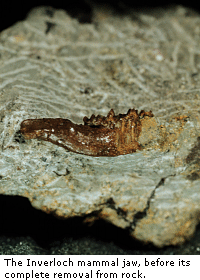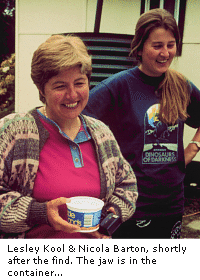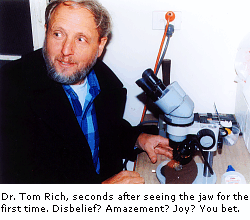Dinosaur Dreaming
Saturday 8th March 1997:
Day of the mammal jaw
Lesley Kool,
Chief Preparator & Dig Leader
It was the end of the fifth week of the dig at Flat Rocks, Inverloch, with one week to go. It was also the day of the annual "Dig Party". The party had established itself in the first year of our field trips to Inverloch in 1994, when we celebrated my daughter Amanda's 21st birthday and grad student Andre's imminent departure to Europe. After that, it was taken for granted that we would hold a "Dig Party" on the Saturday before the last weekend of the field trip.
The Flat Rocks site is on the shore platform approximately five kilometres south west of Inverloch, and is only accessible between 3-4 hours either side of low tide. Large blocks of sandstone conglomerate are excavated from the exposed fossil layer and systematically broken down, using hammer and chisels, to small chunks the size of an ice cube, or smaller. Any rock not broken down on site is carried back up to the house. On this particular Saturday, the low tide was late in the day, so most of the crew were breaking rock at the bottom of the back garden of the house we had rented for the duration of the dig.
It was about 10:45 a.m. and I was sitting on the concrete edge of the porch at the back of the house, trying to catch up on the backlog of fossil bones waiting to be checked. Nicola Barton, an English archaeologist, who had joined us the previous year and returned for a second season, walked up from the rock breaking area holding two walnut size pieces of rock.
"Do you want this?"
"Do you want this?" she asked, handing the two small pieces to me. I usually have my hand lens hanging around my neck on a thong, but because I had been using the microscope to check some of the most recent finds, I had not bothered to put it on.
I looked at the broken surface of the two halves of rock and saw that they were marked with streaks of reddish-brown iron stains. Amongst the stains on each matching broken surface was a tiny fragment of brown bone. Not much different from hundreds of other tiny scraps of bone that I had looked at over the last four years.
"How on earth did you spot that amongst all the iron-staining?" I asked. Nicola just smiled and shrugged her shoulders.
"Do you want it?" she asked again.
"I'll check it under the microscope later" I replied, placing the two pieces of rock down beside me while I finished what I was doing.

Ten or so minutes later, I had to check another small bone so I picked up Nicola's rocks and took them to the microscope. As I focussed on the first of the two halves of the bone, I could hear Doris and Andre in the kitchen, busily preparing food for the party. As the bone came into focus, the first things I saw were five tiny pointed teeth, broken dorso-ventrally. My first reaction was another fish-jaw. To the left of the teeth was a loose fragment of matrix, so I casually flicked it off with the point of my needle.
A surprise revelation
Under the rock I saw another tooth, but this one was only exposed at the base of the crown and was unbroken. I saw what looked like the base of three cusps and immediately realised that it was not fish, but what was it? I then looked at the broken teeth again and saw that what had looked like five pointed teeth were, in fact, two teeth with two cusps each, and the last tooth on the right had only one cusp showing. I also noticed that the jaw was broken obliquely, exposing what looked like a cross-section through two roots. I then picked up the second piece of rock and looked for the counterpart. It was there and so were the other halves of the broken teeth.
The jaw appeared to have broken quite cleanly, with only a partial cusp missing. I don't know how long I sat there staring at this tiny jaw fragment, but I could feel the excitement building in me as I began to realise what I was looking at. For thirteen years I had seen various exposures of jaws of different animals, mostly dinosaurs, fish or turtles, but I had only seen jaws like this one in textbooks, and I was unwilling to believe what I was seeing.
In my calmest voice I called to Andre in the kitchen to come and look at something for me. He was munching on a piece of garlic bread as he sat down on the seat I had just vacated.
"Could you just check this for me?" I asked, and handed him the first half of the jaw. He chewed on his bread for a few seconds before gulping and nearly choking. I can't remember what he said as I was laughing at his reaction which was enough to tell me that he was thinking the same as me. We then called Doris out to look at it and she reacted in her own inimitable way by saying "Oops!" Then she turned to Andre and I and said
"Am I seeing the same thing you saw?"
By this stage I knew we could not all be wrong.
Andre called to Nick, who was busily breaking rock at the bottom of the garden. He called twice, but with no response. So I decided to go and fetch him. I casually walked down the garden towards the rock breakers, trying not to appear too excited. As I approached Nick, he looked up and I quietly asked him to come and look at something under the microscope. He mumbled something then ambled up to the house. The excitement was building as he returned to the rock-breaking area. He then sat down next to Nicola, who was completely oblivious of what was going on, and said:
"You're going to get very fat!"
This was a referral to the cubic metre of chocolate that Dr. Tom Rich had offered to the first person to find a mammal in the Early Cretaceous of Victoria. This honour had already been won the previous year for a monotreme humerus that had been uncovered from Dinosaur Cove in the Otways. However, Nick's statement totally baffled Nicola, who had no idea what he was talking about. I felt it was time to set her straight. So I explained that the little bone she brought me was probably a mammal jaw. None of us wanted to say for sure until Tom had seen it and he had promised to be there for the party tonight.

Once Nicola had been shown the jaw, the news quickly spread to the rest of the crew and everyone lined up at the microscope to get a peek. The Vertebrate Palaeontology of Australasia book was brought from the lounge room where a small library of relevant books and papers were available for perusal. Tom's chapter on Australian mammals was found and we tried to compare what we could see down the microscope with the line drawings on the pages.
What's in a name?
At the start of the dig Nick had come up with a name for the theropod dinosaur we hoped to find, so we modified the name to suit a mammal - "Nictotherium strzeleckii".
We all agreed not to say anything to anyone until Tom saw it, just in case we had got it wrong. Having spent his professional career looking at mammals, Tom would know if it was or not.
The rest of the day was a blur of excitement and expectation. After lunch, most of the crew went down to the site and worked until 6 p.m., while Mary and Nicole did the last minute shopping for the party. During the afternoon I kept looking up towards the car park, hoping to see Tom arrive, but he never showed.
Back at the house, we quickly showered and got ready for the party. During the afternoon some of the previous crew members had arrived and by 7 p.m. there were some 30 people at the house, but no Tom. He had not arrived until late in the evening of last year's party so we were still hopeful. It was decided that if he did not turn up tonight then I would ring him tomorrow morning, but that would spoil the surprise. However, we did not have to depend on plan B as shortly after 8 p.m. he arrived with John Herman, a fellow Dinosaur Cover.
Tom sees the Grail...
Once he had greeted those crew members he knew, we went into the kitchen, where he asked me the inevitable question:
"Well, have you got anything exciting to show me?"
Not wanting to give anything away, I casually explained that we had a couple of bones that I thought he would like to see, but I would need to sett up the microscope. At this stage, it was getting rather crowded in the kitchen as people prepared the food. So Tom said "Look, don't worry about it now." I immediately thought "Oh Hell, I've blown it." But then Tom added, "Unless you have something really exciting... like a mammal skull"
Andre had been standing close to us as we talked and I looked at him as Tom said this. At the same time we both turned to Tom and said "No".
The look of expectancy dropped from Tom's face, so before he could say any more I asked Andre to set up the microscope while I fetched the jaw. I had written the name we had chosen for it on the lid of the margarine container, so as Tom followed me into the bedroom where I had put it for safe keeping, I quickly removed the lid so he could not read it.
As I set up the first small fragment under the microscope there was an sense of anticipation in the air as the rest of the crew surreptitiously gathered around. I then vacated the seat to allow Tom to settle himself. Andre had the camera ready to capture Tom's reaction. For what seemed like ages Tom sat hunched over the microscope, peering down onto the tiny fragment, then he whispered "My God", as the realisation of what he was looking at sank in.

He then looked and said "My Lord!" as Andre took the photo. I clapped him on the shoulder and said "I told you it wasn't a skull", to which he replied "Jesus Christ!"
He took another long look, before collapsing back in the chair with a happy stunned look on his face. At this stage everyone was cheering and hugging each other, because we knew that it really was a mammal jaw. I then turned over the margarine lid and said
"We've even thought of a name for it". Tom read the name "Nictotherium strzeleckii" and hmmmed. "We'll see" he said.
We introduced Tom to Nicola, and Andre took another photo and then Tom said he had to ring Pat. While he was on the phone the rest of the crew members who had not seen it yet lined up to gaze upon this little jaw that Tom had been looking for for nearly 24 years.
The rest of the evening was spent trying to decide if it was a monotreme or primitive marsupial or maybe even a placental mammal. The final results would have to wait until I had prepared it and Tom had a chance to study the teeth. Doris and Nicola had bought champagne in anticipation and so Tom toasted "Nictotherium strzeleckii" (Ed: now officially called Ausktribosphenos nyktos) and the success of the dig. Needless to say, I did not sleep well that night. |